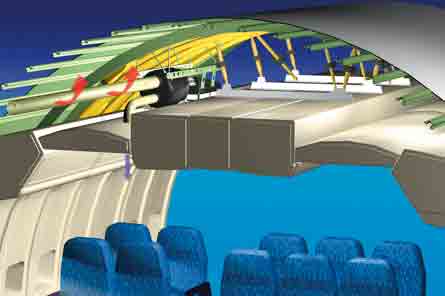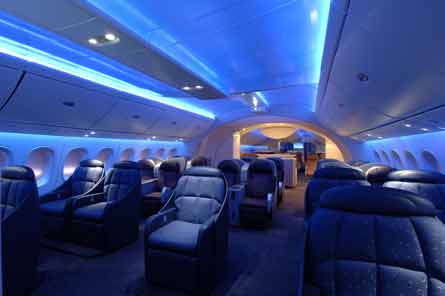A focus on human factors, such as air and water quality and humidity levels, should ensure that the 787 cabin offers passengers a new level of comfort
The 787’s cabin is the focus of intense development work, particularly as it is the obvious “showcase” of the programme from Boeing’s sales perspective. But Mike Sinnett, 787 systems director, says: “It’s not just marketing, it’s real hard science. We’re working human factors as well as areas like cleaner water and air and improved thermal control.”
He adds: “We’ve learned things like control of volatile organic compounds [VOC] is more important than humidity, which we didn’t expect.” VOCs are found in a wide variety of materials that find their way into a cabin from paints and coatings to underarm deodorant, and have become a major concern of the US Environmental Protection Agency (EPA). They have been found to be a major contributing factor to ozone, a common air pollutant, which has been proven to be a public health hazard.
“So with the suppliers we’ve developed a gaseous air purification system to scrub out VOCs. It’s not new, but we’ve got a system that is around 99% efficient and integrated with a HEPA [high efficiency particulate air] filter; the cabin will have some of the cleanest air in the world,” says Sinnett. The new system, provided by Minnesota-based Donaldson, will filter out gaseous irritants and odours as well as allergens, bacteria and viruses.
The system will work in conjunction with a set of cabin air purification filters supplied by New York-based Pall to Hamilton Sundstrand, as part of the overall air management and environmental control system. The filters will be used in the cabin as well as the electronics bay, cockpit and lavatory and will include HEPA filters, electronic equipment cooling filters, heat exchanger filters as well as galley vent filters. Each 787 air management system requires 15 filters.
Pall says the system will have a submicron particulate efficiency of 99.97%, or the microbial equivalent of outside air, and uses the company’s proprietary “Ultipleat” filter. This is a deep-pleated design with extended maintenance intervals of 6,000-8,000 flight hours or equivalent to two years versus the normal 12-18 months.
Relative humidity, nonetheless, remains a major selling point of the 787 cabin. Due to its largely composite construction, Boeing believes it will be able to offer a significantly more comfortable humidity level of around 14% for cruise, compared with average values in the single digits in current long-haul aircraft. The average home, by contrast, has a relative humidity in the 50% range.
Environment control
To offset the effects of this higher cabin humidity, plus the usual high levels of cold-induced aircraft skin moisture, Boeing is also providing as standard the CTT Systems-developed Zonal Drying system. Representing the biggest breakthrough in the Swedish company’s history, the 787 deal covers installation of systems throughout the cabin. Each unit consists of a fan, a heater and a glassfibre rotor impregnated with silica gel. The system takes air from the cabin, removing the moisture using the silica-coated rotor, before blowing the air (80% of which is now dry) into the space between the cabin lining and the aircraft’s outer skin.
|
|---|
The Zonal Drying system will pump dried-out air into the space between the cabin lining and the aircraft skin. |
The remaining air, which has been warmed by the heater, is passed through the rotor – reabsorbing some moisture and drying out the rotor at the same time. This moist air is then recirculated into the cabin.
|
|---|
By adopting composite structures, Boeing hopes to avoid condensation problems |
Another passenger environment feature will be a lower cabin altitude of 6,000ft (1,830m), compared with the more traditional 8,000ft. “We settled on 6,000ft, because that’s where you get the most ‘bang for your buck’,” says Sinnett who adds that, according to a Boeing-Ohio State University altitude study, the percentage of passengers reporting overall “well-being” improves dramatically with a decrease in cabin altitude. At 8,000ft the level of “happy” passengers was just over 80%, with this increasing to over 95% at 6,000ft. “To do this in the aluminium world would have required several thousand pounds more weight [to reinforce the structure], but with composites this isn’t an issue.”
Air conditioning will be provided by two Hamilton Sundstrand air-cycle packs. Working together, and each controlled by two identical dual-channel, fully digital pack control units (PCU), the two packs form the cabin air conditioning and temperature control system. This will provide cabin heating and cooling for passenger, crew and cargo zones in what Hamilton Sundstrand believes will be the most closely controlled environment ever provided on a commercial aircraft. The PCU at the heart of the system uses advanced processing features to acquire data from several types of sensor, including pressure and temperature, as well as providing accurate and real-time control of its motor control outputs.
Eaton was selected by Hamilton Sundstrand air management systems to design, develop and supply ducting and associated hardware for use on both the nitrogen generating system and the cabin air conditioning and thermal control system. Both the air-cycle packs and nitrogen system are currently running at Hamilton Sundstrand’s Windsor Locks site in Connecticut.
Another of the most advanced 787 cabin systems will be the electrochromic windows. Replacing the traditional pull-down plastic shades, which Boeing says are notoriously prone to sticking and are a maintenance headache, the hi-tech window shading system is being developed by Huntsville, Alabama-based PPG Aerospace, in association with Gentex of Zeeland, Michigan, a maker of automatic-dimming rearview mirrors and commercial fire protection products. PPG will develop a variably dimmable cabin window that will allow the passenger to select up to five different levels from dark to clear. The windows will also have a manual override for use by the flight crew.
The dimmable electrochromatic window panels will be inserted between the exterior cabin window and an interior plastic dust cover. A low electrical charge will darken a conductive medium between the layers, with transmissibility – or lightness – increasing with reduced voltage. Boeing says the window systems will not only provide light control, but also enhance the “coolness” of the interior appearance and comfort of the aircraft. The new windows are also designed to reduce light and heat transmittance into the cabin, even when on the most “open” setting, which is expected to reduce the load on the heating and air conditioning system.
Prototype panels will begin tests at Boeing this year with first production units due to be produced for flight evaluation by the fourth quarter of 2006, and production line shipments beginning in mid- to late-2007.
Meanwhile, GKN Aerospace is developing the actual windows for the 787 which will be 50% larger than typical aircraft windows and will, says the UK-based company, “use specialist coatings more akin to the advanced coatings applied to fighter aircraft canopies, giving the airline passenger solar protection as well as containing the IR transmissions given out by the new in-flight passenger communication systems installed in the 787”.
The GKN-made windows will be a laminated “sandwich” design, rather than the more typical “air gap” construction, which it says “will alleviate the condensation seen by passengers in many of today’s cabin windows”.
|
|---|
Boeing believes a gaseous air purification system will make the 787 cabin air among the cleanest anywhere in the world |
Hamilton Sundstrand’s recently acquired Kidde Aerospace & Defense company has been selected by Boeing to supply smoke detectors for the 787 crew rest compartment and lavatories. Kidde, which was earlier awarded contracts to provide fire-suppression and protection systems for the 787’s cargo compartments and electronics bays, is to base the system on a variant of its Model 3000 detector device and “will probably use an APU tailcone to do fire suppression tests and off-load aircraft testing”, says Hamilton Sundstrand aerospace systems president Tim Morris. “For cargo smoke and fire detection system tests we have a whole cargo bay mocked up at Kidde’s Wilton site in North Carolina,” he adds.
Freight capacity
Below decks, Boeing is provisioning the 787-3 and -8 to hold up to 16 LD-3 cargo containers, or five 96 x 125in (2.4 x 3.2mm) pallets (or five 88 x 125in pallets) in the forward cargo bay and 12 LD-3s or three 96 x 125in pallets (or four 88 x 125in pallets) in the aft. The bulk cargo bay can, meanwhile, take up to 11.4m3 (402ft3) of freight. The longer -9 takes up to 20 LD-3s in the forward bay and 16 LD-3s in the aft, while bulk space remains unchanged. The forward lobe of the larger 787 can equally take up to six freight pallets, while the aft can take up to five.
Goodrich supplies the cargo system, and to enable it to be installed in the “pre-assembled” fuselage sections being supplied from Italy, Japan and the USA, has designed it in full co-operation with the structural partners. “For the first time we’ve developed the whole system in a fully integrated process, and that’s a first in Boeing history,” says Goodrich cargo systems vice-president and general manager Tim Dumbauld.
Low weight was a key discriminator during the supplier selection, and the focus remains as intense as ever, says Dumbauld. The system is made up of 50mm power drive units, rollers in the floor and a control system.
Dumbauld adds:“We’re at the point of finalising the interface and harmonising the supply of the first schedule of shipments. We’re shipping parts to Japan, Alenia, North Carolina, Spirit in Wichita and Seattle. Spirit will be getting them first at the end of the year.” ■
Source: Flight International


























